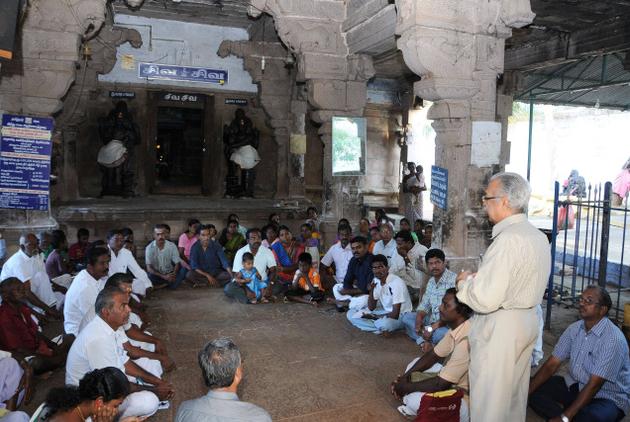
Over 60 inscriptions immortalize history on the stone walls of a 1000-year-old Shiva temple in Sivapuripatti
“When Kulothunga Chola-I subjugated the Pandya kings in the 11th Century A.D., Jainism had taken roots in the Pandya country. A staunch saivaite, Kulothunga decided to resurrect the lost religion and constructed Shiva temples and mutts across the region,” narrates art historian Dr. R. Venkatraman. “Most of these places functioned as centres propagating Saivism and were situated along the major trade routes. These were also the places for the monarchs to rest.”
One such Shiva temple was built at Sivapuripatti, a village situated on the legendary trade route connecting two ancient ports — Muziris on the west coast and Thondi on the east. “The Chinese traders landed in Thondi port, while the Romans used Muziris,” says Venkatraman. “The route which was later maintained by Rani Mangammal, exists till date and passes through a number of villages.”
Today, Sivapuripatti in the present Sivaganga district is much like any other village with tiled-roof houses, dry ponds, barren fields and tall trees under which men play Dhayam and Kattam. Probably, this was how the kings and traders also played in leisure when they stopped at the mutts in the village en route to business and wars.
Not a single mutt said to be built by the Cholas is seen today. Only the temple of Suyamprakasham stands intact, bearing a slew of 60 inscriptions on its stone walls.
Each inscription tells a story from the past, about royal families, peasants, damsels and warriors. “These inscriptions in Tamil script belong to different time periods starting from 11th to 17th Century A.D., showing that the village was inhabited continuously and a number of kings passed through this place,” says Dr. V. Vedachalam, Retd. Archaeological Officer.

Apart from four inscriptions by Kulothunga-I, few date to the reigns of medieval Pandya kings Srivallaba, Parakrama, Kulsekara, Sundara and Vikrama Pandya. Some also refer to Vijayanagara kings like Achutharaya and NagamaNayaka and the much later Polygars such as Vijaya Ragunatha Setupati of Ramnad and the Marudu Brothers of Sivaganga.
One of the inscriptions records the existence of 10 dancers in the temple and a nattuvangar who choreographed the performances during festivals. Another refers to a peace treaty signed between two clans that ruled the region – Nishada Rajans of Pon Amaravathy and Dwarapati Velans. It elaborates on the practice of giving lands in charity to families of martyrs.
Yet another inscription talks about how King Maravarman Sundara Pandya installed an idol of his predecessor Moothanayagan in the temple premises.
“The Inscriptions state that Sivapuripatti was called Nirubasekara Chaturvedi Mangalam and Chola Marthanda Chaturvedi Mangalam during various eras,” says Vedachalam, who also postulates that the village could have been among the 300 hamlets that constituted the kingdom of Pari.
“The Sangam literature sings the glory of Piranmalai which is close by and Sivapuripatti could have very well been a part of Pari nadu.”
“A Panchaloha Nataraja idol was apparently consecrated here, though we don’t find it now,” says Vedachalam. The village people say that the idol was taken to the Archaeological research centre in Chennai, a few years back.
Another rare idol found in the temple is that of Jyeshta Devi, along with Nandikeshwara and Agni.
“This can only be found in Pandya period temples. Jyeshta Devi was the clan-deity of Pandyas and symbolizes fertility,” says Venkatraman. “The temple reflects both Pandya and Chola architectural elements. The short vimana is a trademark style of the medieval Pandyas.”
Sivapuripatti is two kilometres from Singampunari and can be reached via Kottampatti.
The heritage walk was jointly organized by DHAN Foundation, INTACH and Travel Club.
source: http://www.thehindu.com / The Hindu / Home> Features> MetroPlus / by A. Shrikumar / Madurai – September 19th, 2014